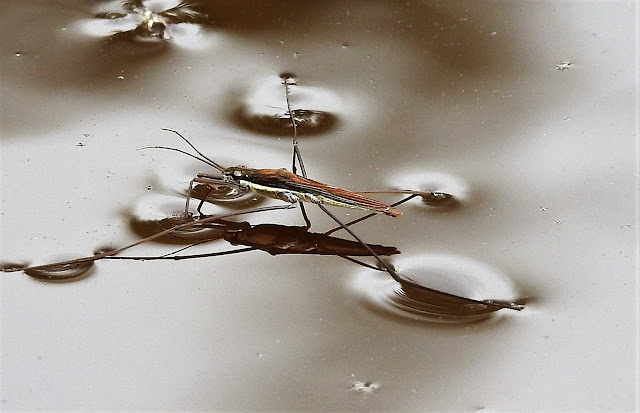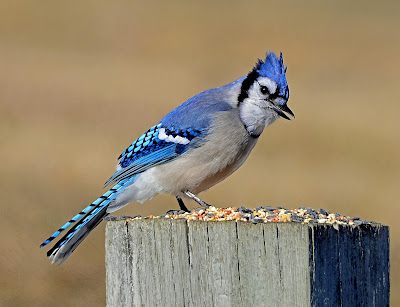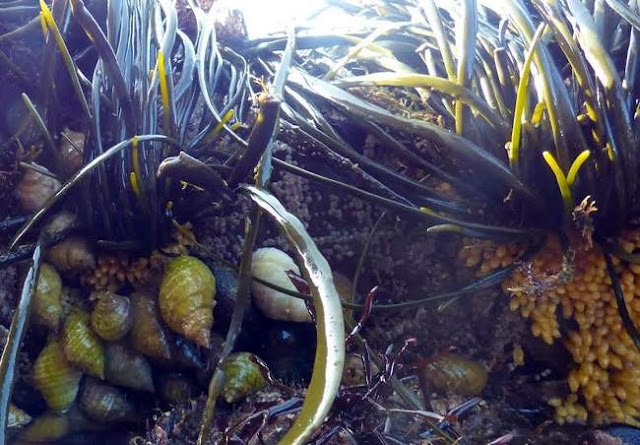Water Striders Hang Out on Water's Surface
by Sue Pike
July 25 2017 The York Weekly/Portsmouth Herald/Foster's Daily and online at seacoastonline.com .....etc
What better summer pastime than sitting by a pond on a hot day? The frogs are languidly croaking, and the mosquitoes are not so terrible at the moment so just a few are buzzing by your ear. The surface of the water is a still and clear as glass, the surface broken only by the occasional minnow rising or a water strider skimming over the surface, tiny dimples where its feet touch the water.
July 25 2017 The York Weekly/Portsmouth Herald/Foster's Daily and online at seacoastonline.com .....etc
What better summer pastime than sitting by a pond on a hot day? The frogs are languidly croaking, and the mosquitoes are not so terrible at the moment so just a few are buzzing by your ear. The surface of the water is a still and clear as glass, the surface broken only by the occasional minnow rising or a water strider skimming over the surface, tiny dimples where its feet touch the water.
As a biology teacher, I love the water strider. Whenever the topic of water and why it is vital for life on Earth comes up, we talk about the amazing properties of water, one of which is that water molecules are sticky. Water molecules like to stick to other water molecules to the exclusion of other molecules, air for example. So, when you have an air-water interface the water molecules will form something akin to a skin (this is called surface tension, and, scientifically, is not a “skin” but looks like one because the water molecules at the surface are sticking so strongly to each other and not to the air it makes it more difficult to break through that surface tension than to move around in the water beneath the surface). Because water has a high surface tension, some organisms, like water striders, can walk on it instead of breaking through.
I was watching some water striders on a neighborhood pond and wondering why
 |
| Water striders legs characteristic dimples where they touch the water Sue Pike photo |
There are quite a few species of water strider found in North America. As members of the class Insecta water striders have three pairs of legs. The front legs are much shorter than the back two sets of legs. The short front legs are used to catch prey - they eat any kind of aquatic insect or larvae they can find (mosquitoes and dragonflies are typical prey). The back two sets of legs are used to walk on the water. They are very specifically designed for this - attached to the thorax in a way that is optimal for water striding but doesn’t work at all for walking on land.
Not all insects can walk on water; water striders can because they have very fine hairs on the undersides of their legs that trap air and repel water (the scientific term for this is superhydrophobic). There is an incredible video on the American Association for the Advancement of Science website (www.sciencemag.org/news/2014/03/secret-walking-water) that shows what researchers have learned about how water striders seem to move so effortlessly on a pond’s surface: “By vigorously rowing along the surface, striders create swirls that help propel them forward, all without rupturing the water surface.” I highly recommend watching this - you will look at water striders with an entirely new appreciation. They are incredibly fast - they can move at the speed of a hundred body lengths per second, this is like a six-foot tall person running at 400 miles per hour.
Watching water striders can be a great way to while away a summer afternoon, but I recommend against trying to pick one up. I’ve read that water striders don’t bite humans, but know from experience (my kids picking them up, not me) that they can inflict a painful “bite.” (I’ve never actually verified whether this is a real bite or imagined, but the shriek from my son seemed real). They have piercing mouthparts that can pierce their prey’s exoskeleton and suck out the juices. This is what they do to one of their favorite prey, mosquito larvae. They grab the mosquito larvae by its breathing tube when it comes up to breath, pulls it through the surface of the water and sucks it dry... it is always a good thing to have some water striders around.



Hello Sue,
ReplyDeleteNice to e-meet you!
I have just stumbled across your blog and I love your writing. I am contributing to what will be an open-source textbook on microclimates and hydrology, where I'm writing up the chapter on physical properties of water. As I write about surface tension/adhesion/cohesion I always think back to the curio of a water strider. And, I think I stumbled on the exact video you mention here a couple of years back... anyhow.; i am wondering how you'd feel about reproduction of your image of the water strider in the textbook (with proper credit and sourcing of course) as i think it is just fabulous and bodes perfectly well as a visual to explain what is truly a beautiful ecological process. It is of course not the same to just grab a random image from google; i would of course like to use one that has a meaning behind it: to you, being a science educator i would just like to include that and give credit to such amazing work you, among the many others who there are, and what you are doing!
There is absolutely no pressure for a response, but please accept my many thanks in advance and stay well.
Bryant - bryantserre@gmail.com